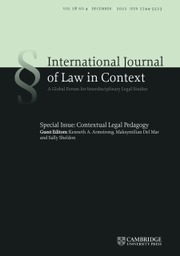No CrossRef data available.
Article contents
Continuities and disruptions in the National Council of Justice’s strategy of AI implementation in Brazil: the data-seafarers of Justice 4.0
Published online by Cambridge University Press: 04 December 2024
Abstract
The introduction of algorithms in courts is currently the object of much scrutiny, attempting to find balance between increasing efficiency to the legal system and avoiding associated risks. This paper aims to explore how the judiciary organisations responsible for implementing algorithms describe the temporal demands of continuity and change, through a case-study of the Brazilian National Council of Justice (CNJ). Through its centralised, collaborative and open-access based platform, the CNJ views algorithms as a necessary step to deal with excessive case-load, and as a rationality-instituting mechanism for a currently dysfunctional situation. It attempts to deal with risks of disruption by placing itself in a supervisory role regarding all algorithms developed by courts across the country, ensuring the quality of the data and excluding the moment of judicial decision-making from automation, but this does not exclude the representation of the new technology as an instrument to implement specific doctrinal positions.
- Type
- Article
- Information
- International Journal of Law in Context , Volume 20 , Special Issue 4: Property in the Sharing Economy: Paradox, Disruption, and Institutional Design , December 2024 , pp. 617 - 634
- Copyright
- © The Author(s), 2024. Published by Cambridge University Press


